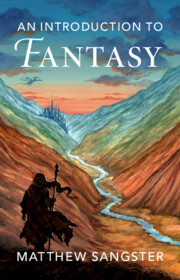30 results
Mass, Iteration, and Pejoration: On the Evolution of Iterative Adverbs from Indefinite Quantifiers in German Varieties
-
- Journal:
- Journal of Germanic Linguistics / Volume 35 / Issue 4 / December 2023
- Published online by Cambridge University Press:
- 29 November 2023, pp. 339-370
-
- Article
-
- You have access
- Open access
- HTML
- Export citation

An Introduction to Fantasy
-
- Published online:
- 07 October 2023
- Print publication:
- 07 September 2023
2 - The Value of Iteration
-
- Book:
- An Introduction to Fantasy
- Published online:
- 07 October 2023
- Print publication:
- 07 September 2023, pp 97-161
-
- Chapter
- Export citation
Envoi
-
- Book:
- An Introduction to Fantasy
- Published online:
- 07 October 2023
- Print publication:
- 07 September 2023, pp 432-436
-
- Chapter
- Export citation
Chapter IV - Time For Allusion
-
- Book:
- Markers of Allusion in Archaic Greek Poetry
- Published online:
- 11 May 2023
- Print publication:
- 25 May 2023, pp 244-327
-
- Chapter
-
- You have access
- Open access
- HTML
- Export citation
Appendix I - Topics in C++
-
- Book:
- Programming in Parallel with CUDA
- Published online:
- 04 May 2022
- Print publication:
- 02 June 2022, pp 438-447
-
- Chapter
- Export citation
6 - Taylor Series Expansion and Application in Error Estimate
-
- Book:
- Time Series Data Analysis in Oceanography
- Published online:
- 21 April 2022
- Print publication:
- 05 May 2022, pp 110-129
-
- Chapter
- Export citation
Naming Others: Translation and Subject Constitution in the Central Highlands of Angola (1926–1961)
-
- Journal:
- Comparative Studies in Society and History / Volume 64 / Issue 2 / April 2022
- Published online by Cambridge University Press:
- 01 April 2022, pp. 363-393
-
- Article
- Export citation
On the dimension of points which escape to infinity at given rate under exponential iteration
- Part of
-
- Journal:
- Ergodic Theory and Dynamical Systems / Volume 42 / Issue 5 / May 2022
- Published online by Cambridge University Press:
- 29 March 2021, pp. 1591-1623
- Print publication:
- May 2022
-
- Article
- Export citation
Section I - Develop Your Creative Abilities
-
- Book:
- Creativity in Research
- Published online:
- 11 July 2019
- Print publication:
- 01 August 2019, pp 21-124
-
- Chapter
- Export citation
5 - Iterate and Experiment
- from Section I - Develop Your Creative Abilities
-
- Book:
- Creativity in Research
- Published online:
- 11 July 2019
- Print publication:
- 01 August 2019, pp 94-124
-
- Chapter
- Export citation
Challenges 45–51 - While Loop
- from Part I - Learning Python
-
- Book:
- Python by Example
- Published online:
- 28 May 2019
- Print publication:
- 16 May 2019, pp 40-44
-
- Chapter
- Export citation
Challenge 149 - Times Table (GUI)
- from Part II - Chunky Challenges
-
- Book:
- Python by Example
- Published online:
- 28 May 2019
- Print publication:
- 16 May 2019, pp 161-163
-
- Chapter
- Export citation
Challenges 35–44 - For Loop
- from Part I - Learning Python
-
- Book:
- Python by Example
- Published online:
- 28 May 2019
- Print publication:
- 16 May 2019, pp 35-39
-
- Chapter
- Export citation
Challenge 148 - Passwords
- from Part II - Chunky Challenges
-
- Book:
- Python by Example
- Published online:
- 28 May 2019
- Print publication:
- 16 May 2019, pp 156-160
-
- Chapter
- Export citation
Challenge 146 - Shift Code
- from Part II - Chunky Challenges
-
- Book:
- Python by Example
- Published online:
- 28 May 2019
- Print publication:
- 16 May 2019, pp 150-152
-
- Chapter
- Export citation
Challenge 147 - Mastermind
- from Part II - Chunky Challenges
-
- Book:
- Python by Example
- Published online:
- 28 May 2019
- Print publication:
- 16 May 2019, pp 153-155
-
- Chapter
- Export citation
An iterative implementation of the implicit nonlinear filter
-
- Journal:
- ESAIM: Mathematical Modelling and Numerical Analysis / Volume 46 / Issue 3 / May 2012
- Published online by Cambridge University Press:
- 11 January 2012, pp. 535-543
- Print publication:
- May 2012
-
- Article
- Export citation
ON THE UNIFORM PERFECTNESS OF THE BOUNDARY OF MULTIPLY CONNECTED WANDERING DOMAINS
- Part of
-
- Journal:
- Journal of the Australian Mathematical Society / Volume 91 / Issue 3 / December 2011
- Published online by Cambridge University Press:
- 04 November 2011, pp. 289-311
- Print publication:
- December 2011
-
- Article
-
- You have access
- Export citation

